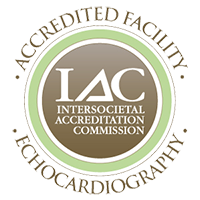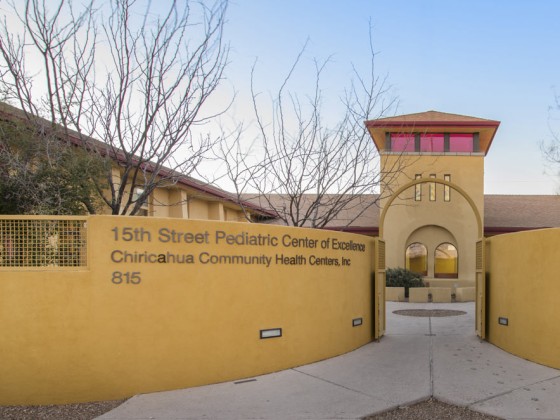The Non-Invasive Cardiodiagnostics department at Phoenix Children’s, also known as the Echo Lab, is designed to provide testing for patients who have a diagnosis or a suspicion of having congenital heart disease or heart failure. Once a cardiologist makes a diagnosis of a congenital heart issue, heart disease, or wants to rule out any problems in the heart, our department performs the imaging tests that show the doctors the heart and how well it performs.
What is Echocardiography?
Echocardiography is a type of medical imaging that uses ultrasound to look at the heart and through images and measurements. These images help the cardiologist, assess the heart's structure and function. This type of imaging shows us how the blood moves through the heart valves, chambers and major blood vessels connected to the heart. This test is also called an ECHO, cardiac ultrasound, heart ultrasound, heart sonogram, or transthoracic echocardiogram (TTE).
Types of Echocardiography
There are several kinds of echocardiography procedures. The type of procedure a patient will have depends on what information the healthcare provider is seeking. The most common type is the standard echocardiogram which is called a surface echocardiogram (transthoracic echocardiogram) echo. If the ECHO is done with exercise, it is called a stress ECHO. We also perform a special type of ECHO on our pregnant mothers, to look at the heart of the unborn, and it is known as the Fetal ECHO. During a surgery or procedure, another specialized type of echocardiography procedure may be performed, and it involves a probe that goes into the esophagus to look at the heart. This procedure is called the transesophageal echocardiogram or TEE.
Echocardiogram
An echocardiogram, also called an echo or TTE, is the standard type of echocardiogram. This is a non-invasive procedure that uses sound waves to make detailed pictures of the heart and is used to assess the heart’s function and condition. It shows us how the valves open and close, how well the heart squeezes and where the connections are between the heart and major blood vessels. We use Doppler and color flow imaging which allows us to assess blood flow and trace the pathway through the heart. Sometimes we do a ‘bubble’ study, using an injection of saline, to further help us track blood flow. Other less common names for an echocardiogram are cardiac ultrasound, heart ultrasound, or heart sonogram.
- Two dimensional (2D) images are recorded as short movie clips called cine-loops. They are pictures of the heart chambers, walls, valves, and large blood vessels connected to the heart. Every echo will have 2D images of the heart.
- Three dimensional (3D) images are recorded as short movie clips called cine-loops. They show pictures of the heart in three dimensions and are often utilized for surgical planning, post-surgical evaluation and in some cases to get extra data needed that cannot be gained from 2D images.
- Doppler echocardiogram is the part of the test that may be used to measure changes in the pitch of the sound waves as the blood moves through the heart. This helps measure the speed, direction and path of the blood within the chambers, valves and major blood vessels.
- Color flow imaging is another part of the test that may be used to measure the changes in the pitch of the sound waves of the blood and displays those changes using a color map on the 2D or 3D images to help assess the direction, speed and path of the blood through the heart.
Fetal Echocardiography
A fetal echocardiogram is performed during pregnancy and evaluates the heart of the unborn baby by using sound waves. It is another non-invasive test that lets your doctor see the unborn baby’s heart without X-rays.
Transesophageal Echocardiography
Transesophageal echocardiography, also known as TEE or heart scan with endoscopy, is a procedure that uses a small probe guided into the esophagus while a patient is sedated with anesthesia to evaluate the heart and its surrounding blood vessels. This test shows the size and shape of the heart, as well as the heart chambers and valves, and is used for diagnosing structural heart defects. This type of test is frequently used before, during, and after cardiac (heart) surgery to assist with planning and evaluating repairs.
Types of Stress Tests
Stress Echocardiography
Stress echocardiography is an ultrasound test that is performed during exercise on a bicycle (ergometer) to evaluate how well the heart responds to physical activity and maximal exertion. Pictures of the heart will be taken before exercise and during/after exercise so the results can be compared. Sometimes certain measurements are taken to record specific metrics that matter to the patients’ health condition.
ECG Treadmill/Bicycle Test
The ECG treadmill/bicycle test assesses the patient’s heart function/rhythm while under stress or exercising. The heart rhythm is monitored and assessed pre-test, during exercise, and post-test. The exercise is performed on either a cycler ergometer (bicycle) or a treadmill. No cardiac imaging is performed with this test.
Metabolic Stress Test
The metabolic stress test assesses the patient's cardiopulmonary function and exertional dyspnea. Heart function/rhythm is monitored and assessed pre-test, during exercise, and post-test. Using a face mask, metabolic data/lung function is captured while the patient exercises on either a cycler ergometer (bicycle) or a treadmill. No cardiac imaging is performed with this test.
How to Prepare and What to Expect
The majority of these tests will take less than an hour. Please arrive 30 minutes prior to any of the following appointments to check in and get your vitals taken prior to your appointment.
A standard echocardiogram has no special instructions; a patient can eat or drink as normal before the test. Patients are usually asked to take off clothing from the upper body and put on a hospital gown. The patient will have three sticky patches put on their chest that are called electrodes. These patches are used to check the heartbeat and monitor heart rhythms. The sonographer will put gel on a special camera and apply it to the patient’s chest in several places, applying a small amount of pressure at times to see the heart and blood vessels from multiple angles. For more information and photos, please review the Echocardiogram – For kids' booklet, prepared for our younger patients to explain the test.
The echocardiogram uses harmless soundwaves to produce images.
- There are no known risks to the body with ultrasound.
- There is no exposure to radiation with this exam.
Inpatient Locations:
Outpatient Locations:
- Phoenix Children's Hospital - Thomas Campus
- Phoenix Children's Specialty Care - Arrowhead Campus
- Phoenix Children's Specialty Care - Avondale Campus
- Phoenix Children's Cardiology (Tempe)
- Phoenix Children's Cardiology (Scottsdale)
- Phoenix Children's Specialty Care - East Valley
- Phoenix Children's Specialty Care (Tucson)
- Phoenix Children's Cardiology (Douglas)
- Phoenix Children's Cardiology (Safford)
- Phoenix Children's Cardiology (Sierra Vista)
A fetal echocardiogram has no special instructions needed to prepare. The sonographer will put gel on the mother’s stomach and apply a small amount of pressure at times to see the unborn baby’s heart.
The fetal echocardiogram uses harmless soundwaves to produce images.
- There are no known risks to the body with ultrasound.
- There is no exposure to radiation with this exam.
Inpatient Location:
Outpatient Locations:
Transesophageal echocardiography does have some special preparations due to the procedure being performed under anesthesia. These guidelines will be reviewed with the family prior to the patient’s procedure. They will include some form of solid and liquid food restrictions. Because they vary based on the clinical condition of the patient and clinical assessment of the practitioner administering the anesthesia, we cannot list them with accuracy here. Please check with your healthcare provider for any questions you may have.
The transesophageal echocardiography procedure does have risks associated with having the small probe (tube) put in the throat/esophagus. Most commonly is a sore throat for a couple of hours. Other risks Include:
- Difficulty swallowing post procedure
- Weak or scratchy voice
- Throat spasms
- Minor bleeding in esophagus
- Injury to lips, teeth, or gums
- Irregular heartbeat (arrhythmia) from the anesthesia medication
- Nausea from the anesthesia medication
- In rare cases, perforation of the esophagus can occur.
Inpatient Location:
Outpatient Location:
During a stress echocardiogram, patients should be well hydrated. A light snack is allowed but please avoid large meals or any products with caffeine. A patient should wear close-toed athletic shoes such as sneakers. Sandals, crocs or slippers are not allowed for safety reasons. Patients should wear athletic clothing, for females this includes a sports bra. If the patient uses an inhaler, we ask that it be brought along but not used within 4 hours prior to the test as it will affect the results.
The stress echocardiogram has risks due to the exercise component, but they are minimal and rare. However, they do include the following:
- Fainting
- Falling
- Irregularities of the heartbeat
- Wheezing and shortness of breath
- In rare cases, heart attack or death (less than 1 in 10,000 cases)
Inpatient Location:
Outpatient Locations:
During an ECG treadmill/bicycle test, patients should be well hydrated. A light snack is allowed but please avoid large meals or any products with caffeine. A patient should wear close-toed athletic shoes such as sneakers. Sandals, crocs or slippers are not allowed for safety reasons. Patients should wear athletic clothing, for females this includes a sports bra. If the patient uses an inhaler, we ask that it be brought along but not used within 4 hours prior to the test as it will affect the results.
The ECG treadmill/bicycle test has risks due to the exercise component but are minimal and rare. However, they do include the following:
- Fainting
- Falling
- Irregularities of the heartbeat
- Wheezing and shortness of breath
- In rare cases, heart attack or death (less than 1 in 10,000 cases)
Inpatient Location:
Outpatient Locations:
During a metabolic stress test (bike or treadmill), patients should be well hydrated. A light snack is allowed but please avoid large meals or any products with caffeine. A patient should wear close-toed athletic shoes such as sneakers. Sandals, crocs or slippers are not allowed for safety reasons. Patients should wear athletic clothing, for females this includes a sports bra. If the patient uses an inhaler, we ask that it be brought along but not used within 4 hours prior to the test as it will affect the results.
The metabolic stress test has risks due to the exercise component but are minimal and rare. However, they do include:
- Fainting
- Falling
- Irregularities of the heartbeat
- Wheezing and shortness of breath
- In rare cases, heart attack or death (less than 1 in 10,000 cases)
Inpatient Location:
Outpatient Locations:
IAC Accreditation
Phoenix Children’s Echo Lab is proud to have earned the certification of Intersocietal Accreditation Commission for Pediatric and Adult Congenital Echocardiography, Fetal Echocardiography and Transesophageal Echocardiography.
Earning the IAC seal demonstrates that Phoenix Children’s has undergone the rigorous assessment by medical experts in pediatric and adult congenital echocardiography and meets the high standards set forth by the IAC to ensure quality patient care is being given.
The IAC accreditation is an ongoing review of our work for the technical quality of our images, the completeness of our studies, and the adherence to protocols and policies. Our studies are evaluated to ensure they meet the appropriateness criteria for ordering studies, that our results correlate with the results of other imaging studies and that our physician reports are regularly reviewed for completeness, accuracy and timeliness.

Contact Us
If you have questions or need to schedule your next appointment, please contact us at 602-933-3366.
In addition to our Phoenix Children’s locations, we also provide limited service at these partner locations:
- Dignity St. Joseph’s Hospital – Phoenix
- Valley Wise Hospital – Phoenix
- Honor Health Shea – Scottsdale
- Honor Health Sonoran – Sonora
- Tucson Medical Center – Tucson
- St. Joseph’s Hospital – Tucson
- Northern Arizona Healthcare - Children’s Health Center – Flagstaff
- Gila River Health Care – Sacaton
Locations



Phoenix Children's Specialty Care - Arrowhead Campus
6524 W. Sack Dr.
Glendale, AZ 85308

Phoenix Children's Specialty Care - Avondale Campus
1665 N. Avondale Blvd.
Avondale, AZ 85392







